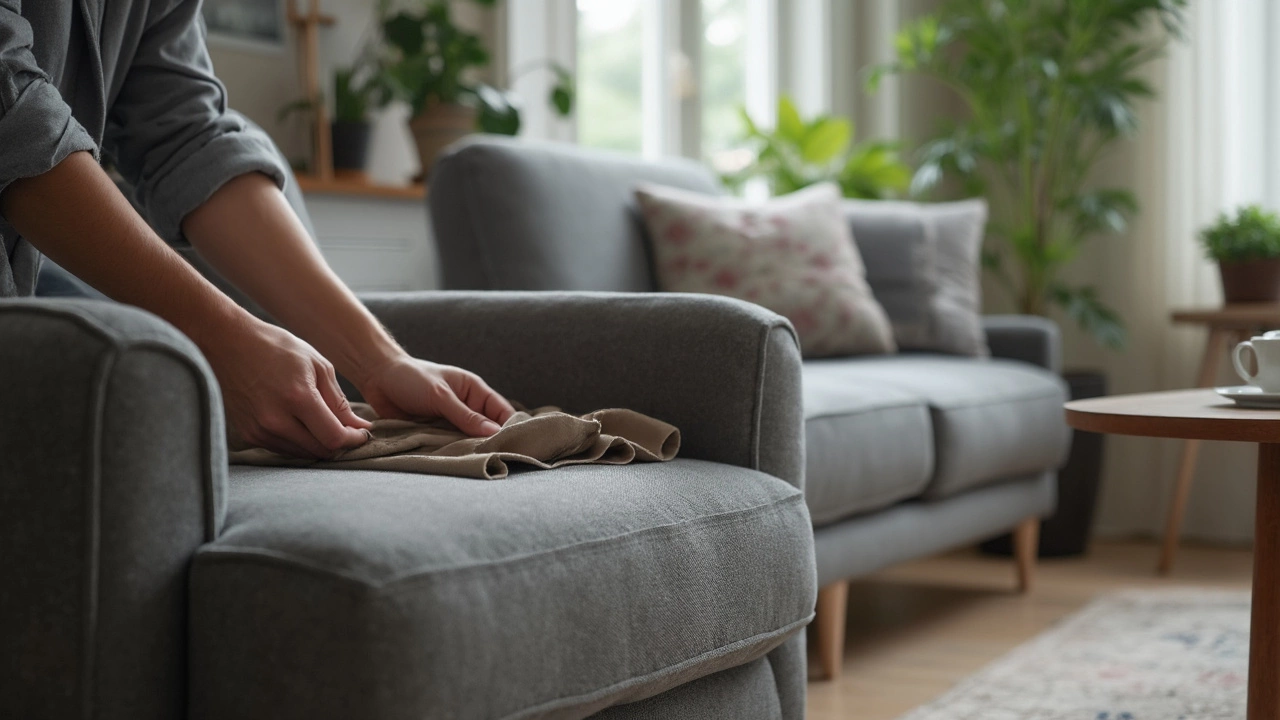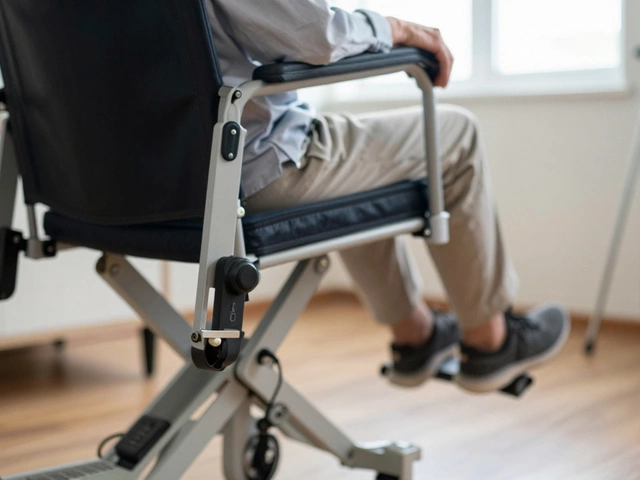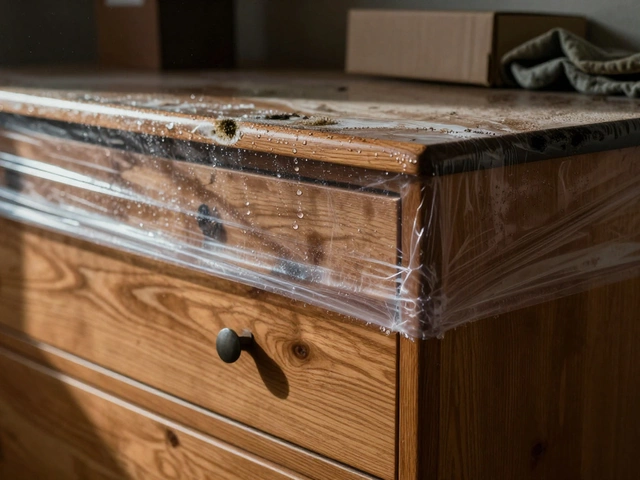 30
Apr,2025
30
Apr,2025
Most people expect their couch to stick around for years, but the real answer might surprise you. The average couch lasts between 7 and 15 years—even less if it’s doing overtime in a busy household. That’s not marketing talk; it’s what furniture repair shops and big upholstery brands report over time. Material type, frame quality, and how you actually use the sofa matter way more than you’d think. Got rowdy kids or pets that treat it like a trampoline? You’re probably looking at the lower end of the spectrum.
If you’re wondering whether to repair or replace that sagging sofa, you’re already ahead of most people. Regular checks for squeaky frames, flat cushions, and frayed fabric can help you avoid a broken couch at the worst moment (like when guests are over). And before you go hunting for a new one, check out smart buying tips—some surprisingly affordable couches hold up just as well as pricey models if you pick the right materials and features.
- The Real Average Lifespan of a Couch
- What Impacts How Long a Sofa Lasts?
- How to Spot a Failing Couch Early
- Ways to Extend Your Couch’s Life
- Signs It’s Time for a New Sofa
- Buying Smart for Long-Term Durability
The Real Average Lifespan of a Couch
So how many years can you really get from a couch lifespan? Most experts and furniture shops say a regular couch lasts about 7 to 15 years before you start noticing real problems: saggy cushions, wobbly frames, or covers that just won’t look clean anymore. If you bought a fancy designer model for a crazy price, don’t be shocked—those don’t always outlast average ones unless you really baby them.
The biggest surprise? The price tag isn’t always the best sign of how durable a sofa set will be. It’s more about what’s inside—like solid wood frames versus cheap particle board, or high-density foam compared to regular sponge. Some quick stats from a 2023 industry study might help give you a ballpark feel for where most couches land:
| Type of Couch | Average Lifespan (Years) |
|---|---|
| Entry-Level (IKEA, budget brands) | 5-7 |
| Mid-Range (Ashley, La-Z-Boy) | 7-12 |
| High-End (Pottery Barn, Restoration Hardware) | 10-20 |
Of course, if your couch is the main spot for naps, movie marathons, or your dog’s playground, expect that lower end of the range. For people who barely use their living room, a mid-range sofa durability could double the lifespan just because of light use.
The bottom line? Don’t just judge by brand or price tag. Know what’s inside your couch materials and how much action it sees every day. If you want to hit the high range of years, it’s about what you buy and how you live, not just what the store swears by in the ads.
What Impacts How Long a Sofa Lasts?
A couch might look awesome when it’s brand new, but not all sofas can take the same daily beating. Several factors decide whether your couch lifespan ends up closer to 15 years or fizzles out after half that time.
Material quality is the first make-or-break. Hardwood frames (like oak or maple) stand up way better than cheap particle board or plastic. High-density foam cushions won’t flatten out as quickly as those made from basic polyfill. And when it comes to upholstery, leather usually beats fabric for long-term durability, especially in homes with pets or kids.
Construction matters. Look for corner blocks, metal screws, and double dowels instead of just staples or glue. These small things keep the joints tight even after years of people flopping down after work. A good suspension system—like sinuous springs or eight-way hand-tied springs—also makes a big difference.
Your everyday habits play a bigger role than most people think in sofa durability. Do you eat every meal on the couch? Does the dog nap in the same spot? Heavy, constant use wears down fabric and cushions much faster than light, occasional lounging.
Here’s a quick look at how some common factors stack up:
| Factor | Good Practice | Result |
|---|---|---|
| Frame | Hardwood (oak, maple) | Longer lifespan |
| Cushions | High-density foam | Stays supportive |
| Upholstery | Leather or performance fabric | Resists wear |
| Use | Light daily use | Less wear and tear |
Don’t forget about sunlight and humidity, either. Direct sunlight fades fabric and dries out leather, while high humidity can cause mold, especially if your sofa sits near windows or in a damp basement. If you want your sofa sets to go the distance, keep them out of direct sun and in a well-ventilated spot.
Bottom line: the mix of raw materials, how a couch is put together, your habits, and even where you place it all go into the final answer for how long your sofa will hold up.
How to Spot a Failing Couch Early
Catching early signs of couch trouble will save you from sudden headaches and help you squeeze every year out of your sofa set. If you're not sure what to look for, here are clear red flags that signal it’s time to look closer:
- Sagging cushions or seats: If you sit down and feel yourself sinking too far, the foam or support is breaking down. Sometimes, it’s the springs going bad, especially if you can feel them poking through after a while.
- Loud squeaks or creaks: A good couch should be silent when you move around. Noises point to a failing frame or loose joints, which often get worse over time.
- Lumps or unevenness: Run your hand across the cushions and backrests. Lumps are a sign the filling has shifted or is wearing out—not a good look or feel for your living room centerpiece.
- Frayed fabric or seams: Check the arms, edges, and anywhere that gets rubbed often. Once the fabric goes, it exposes the inner stuffing, which can quickly make things worse.
- Broken or wobbly legs: If your sofa set rocks or has a leg that feels loose, the whole thing is at risk. Ignoring it can break the frame and derail your couch lifespan for good.
Want to be super clear? Here’s a quick table breaking down the average age when these issues usually start showing up in a couch lifespan based on real repair shop data:
| Problem | Average Age Appears (Years) |
|---|---|
| Saggy cushions | 4-7 |
| Frayed seams/fabric | 6-9 |
| Noisy frame | 5-8 |
| Wobbly legs | 5-10 |
Don’t wait for your sofa durability to surprise you in a bad way. A quick check every few months goes a long way, and if you spot more than one of these problems cropping up, it might be time to plan for a replacement soon.

Ways to Extend Your Couch’s Life
Want your couch lifespan to reach the higher end of that 7–15 year window? It's all about maintenance and habits, not just luck. Small things can add up big time—either saving or shaving years off your sofa’s durability.
- Vacuum and wipe down your couch weekly. Dust, crumbs, and pet hair don’t just look bad—they wear out the fabric and cushions over time.
- Rotate seat and back cushions every couple weeks. This stops that one spot from getting saggy and keeps sofa durability even across the whole surface.
- Keep direct sunlight off your sofa. Sunlight breaks down fibers, fading fabric and even making it brittle. Light-blocking curtains or moving the couch away from windows helps a lot.
- Don’t let spills sit. Blot—not rub—liquids right away to avoid stains and weird smells. Most fabric sofas come with cleaning codes; check the tag and use the right cleaner.
- If you have pets, toss a washable cover or throw on the sofa set. That quick fix protects the fabric from claws and fur—much easier than fixing scratches.
- Don’t overload the couch. It’s meant for regular use, not wrestling matches or standing on it to hang Christmas lights.
Frame and spring care is a thing, too. Every six months, check the legs and frame for wobbling, which can cause early breakdowns. Tighten screws or bolts if anything feels loose.
| Maintenance Routine | Extra Years Added |
|---|---|
| No regular care | 0 |
| Light cleaning, no rotation | ~2 |
| Weekly cleaning & cushion rotation | 3–5 |
| Full care (includes sunlight protection, pet covers, frame checks) | 5–8 |
Following just half of these steps can make a big difference in your couch lifespan. Most people skip these, then wonder why their sofa durability doesn’t measure up. A little effort now means less money spent and fewer furniture headaches later.
Signs It’s Time for a New Sofa
Even the sturdiest couch is going to throw in the towel eventually. Holding onto a worn-out sofa doesn't just mess with the way your living room looks—it's rough on your back and wallet in the long run. So how do you know when it’s really time to swap out for a new sofa set?
- Visible Sagging and Dips: Sit down. Feel like you’re in a hammock? If your cushions won't bounce back or the frame actually sags, no fix will make it like new again.
- Creaks, Cracks, or Wobbly Frame: Noticed more squeaks and groans than usual? That means the internal frame is on its last legs—one wrong move, and it could just collapse.
- Stains and Smells That Won’t Budge: Some stains just won’t quit, no matter how much elbow grease you use. If you’re fighting odors from years of pets, food, or smoke, that fabric’s seen better days.
- Flat or Lumpy Cushions: If your couch feels like you’re sitting on a wooden bench, those cushion foams are likely done for. Good luck getting any real comfort out of that.
- Rips, Tears, and Worn-Out Upholstery: Upholstery wears with time, and while minor fraying is normal, deep tears or stretched-out fabric mean you’re overdue for a replacement.
- Mysterious Backaches: If you notice lower back pain after sofa sessions, your seat cushions may be giving zero support. That’s common with years-old sofa sets.
If you’re still on the fence, here's a quick snapshot from a 2023 home survey on “Why People Replace Their Sofas”:
| Reason for Replacement | Percent of Respondents |
|---|---|
| Frame/Support Issues | 42% |
| Worn Upholstery | 33% |
| Stains/Odors | 18% |
| Outdated Style | 7% |
If your couch is showing two or more of these signs, save yourself the stress and start looking. Think of it as a chance to upgrade how your whole space feels—and your back will thank you.
Buying Smart for Long-Term Durability
If you want a couch lifespan that really pays off, picking the right sofa from the start is everything. It’s not about grabbing the fanciest brand or the biggest sale tag—it’s about looking at what’s under the hood. Let’s cut to the chase.
First, always check the frame. The sturdiest sofa sets use kiln-dried hardwood, like oak or maple. Avoid particleboard and plastic—these materials break or warp way sooner. The joints matter too: look for dowels, screws, or corner blocks (never just glue or staples).
Next up, think about what you’ll sit on every day. High-resiliency foam or spring-down cushions don’t go pancake-flat after a year. There’s a big difference in comfort and durability, so don’t skip this step just to save a few bucks.
The upholstery is a dealbreaker for sofa durability. If you have kids or pets, you want a tightly woven synthetic blend or leather. These hold up against spills, claws, and everyday wear way better than velvet or linen. Some modern treatments even make fabrics stain-resistant out of the box. Here’s a quick breakdown of common materials and their average lifespan:
| Material | Average Lifespan |
|---|---|
| Leather | 15+ years |
| Polyester/Microfiber Blend | 10-15 years |
| Cotton Blend | 7-10 years |
| Linen | 5-7 years |
Don’t forget the warranty. Reputable brands give at least five to ten years on the frame—if they don’t, be skeptical. It says a lot about how much faith they have in their own product. Read the fine print for what’s actually covered.
It’s smart to try out the couch in person if you can. Sit, bounce, even wiggle a bit—you’ll feel a solid frame right away. Bring a tape measure too, since a couch that lasts should actually fit your space, not block every doorway.
- Inspect seams and zippers for strength—loose stitching means trouble ahead.
- Check cushion covers: removable ones are easier to clean and let you swap fillings if needed.
- Avoid impulse buys, no matter how tempting the sale price is.
Investing just a little more time and research in picking the right sofa makes a world of difference. A good one can face years of snacks, naps, and Netflix nights, and still look sharp. Go for quality over hype, and you’ll be set for the long haul.




